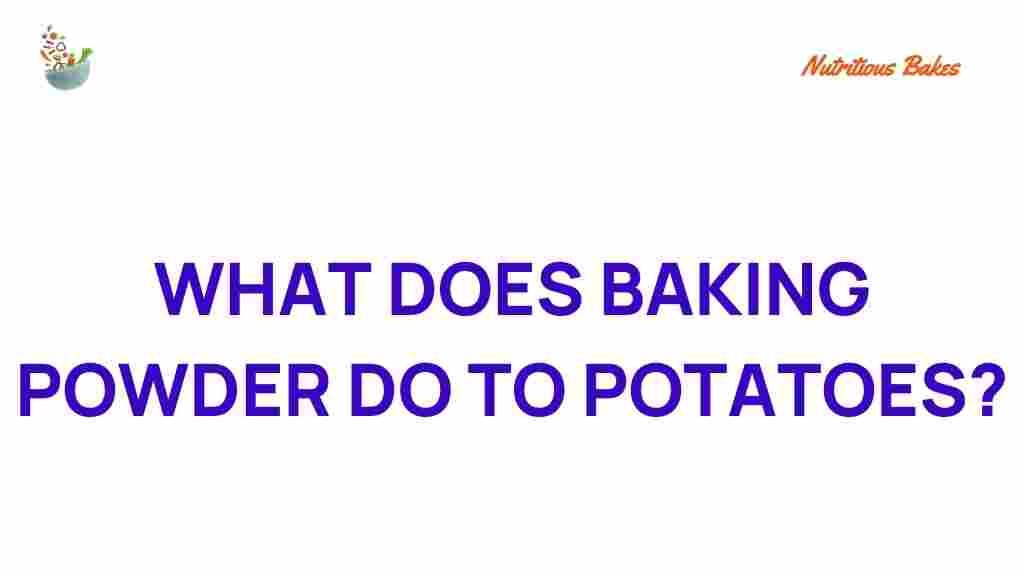The Surprising Science: What Baking Powder Does to Potatoes
When it comes to cooking, potatoes are one of the most versatile ingredients out there. From mashed to roasted, they can be prepared in countless ways. But have you ever thought about how different ingredients can affect the texture and flavor of potatoes? One such ingredient that often goes unnoticed in potato recipes is baking powder. In this article, we will explore the fascinating culinary science behind baking powder and its effect on potatoes, revealing some recipe secrets that can elevate your cooking game.
The Role of Baking Powder in Cooking
Baking powder is a chemical leavening agent that helps baked goods rise. But its application isn’t just limited to cakes and cookies. When used in the preparation of potatoes, baking powder can significantly alter the texture and cooking process.
Understanding the food chemistry behind baking powder will help you appreciate its role in enhancing your potato dishes. Baking powder contains a combination of an acid and a base, usually sodium bicarbonate (baking soda) and a weak acid like cream of tartar. When mixed with moisture and heat, it releases carbon dioxide gas, which causes the dough or batter to rise. This reaction can also be applied to potatoes, leading to surprising results.
How Baking Powder Enhances Potato Texture
One of the most notable effects of baking powder on potatoes is its ability to create a fluffier texture. This is particularly beneficial when making mashed potatoes or crispy roasted potatoes. Here’s how it works:
- Increased Surface Area: When baking powder is applied to the surface of potatoes, it reacts during cooking, causing the outer layer to puff up. This results in a light and airy texture.
- Enhanced Crispiness: For roasted potatoes, the carbon dioxide released from the baking powder creates tiny bubbles in the potato’s surface, leading to a crispier exterior once cooked.
- Moisture Retention: Baking powder can help potatoes retain moisture, preventing them from becoming dry and unappetizing.
Step-by-Step Process: Using Baking Powder with Potatoes
Now that we understand the science, let’s dive into how to effectively use baking powder in your potato recipes. Here’s a step-by-step guide:
Ingredients Needed:
- 2 pounds of potatoes (Yukon Gold or Russet)
- 1 teaspoon baking powder
- Salt to taste
- Water
- Butter or oil for finishing
Instructions:
- Prepare the Potatoes: Peel and cut the potatoes into even-sized chunks to ensure they cook uniformly.
- Boil the Potatoes: In a large pot, add the potato chunks and cover them with water. Add a pinch of salt and bring to a boil. Cook until fork-tender, about 15-20 minutes.
- Drain and Dry: Once cooked, drain the potatoes and let them sit for a few minutes to allow the steam to escape. This step is crucial as it helps to dry out the potatoes slightly.
- Add Baking Powder: Sprinkle the baking powder over the potatoes while they are still warm. Use a fork or masher to gently mix it in. This is where the magic happens!
- Finish Cooking: If you want crispy potatoes, toss them in a bit of oil or melted butter and roast them in the oven at 425°F (220°C) for 30-40 minutes, turning occasionally until golden brown.
Kitchen Tips for Perfecting Your Potato Dishes
Here are some kitchen tips to keep in mind while experimenting with baking powder and potatoes:
- Choose the Right Potatoes: For the best results, use starchy potatoes like Russets for fluffiness or waxy potatoes like Yukon Gold for creaminess.
- Don’t Overdo It: A little baking powder goes a long way. Using too much can leave a bitter taste.
- Mix Evenly: Ensure that the baking powder is evenly distributed among the potato chunks for consistent texture.
- Experiment with Flavors: Consider adding herbs, garlic, or cheese to your potatoes for additional flavor.
Troubleshooting Common Issues
While using baking powder with potatoes can yield fantastic results, you might encounter some challenges. Here are some common issues and solutions:
- Potatoes Too Gummy: If your potatoes turn out gummy, you may have overmixed them. Be gentle when combining the baking powder.
- Bitter Taste: If you notice a bitter flavor, you might have used too much baking powder. Stick to the recommended amount.
- Lack of Crispiness: Ensure you roast the potatoes at a high temperature to achieve that desired crispy texture.
Conclusion: The Science of Texture Enhancement
Using baking powder when cooking potatoes is a simple yet effective technique that can dramatically enhance the texture and flavor of your dishes. By understanding the food chemistry behind this common kitchen ingredient, you can take your potato recipes to the next level. Whether you’re aiming for fluffy mashed potatoes or crispy roasted ones, baking powder is a secret weapon worth incorporating into your cooking routine.
Next time you’re in the kitchen, don’t forget these kitchen tips and recipe secrets to impress your family and friends. Happy cooking!
For more culinary insights and tips, check out our cooking blog.
For scientific explanations and studies on culinary science, visit this resource.
This article is in the category Tips and created by NutritiousBakes Team
